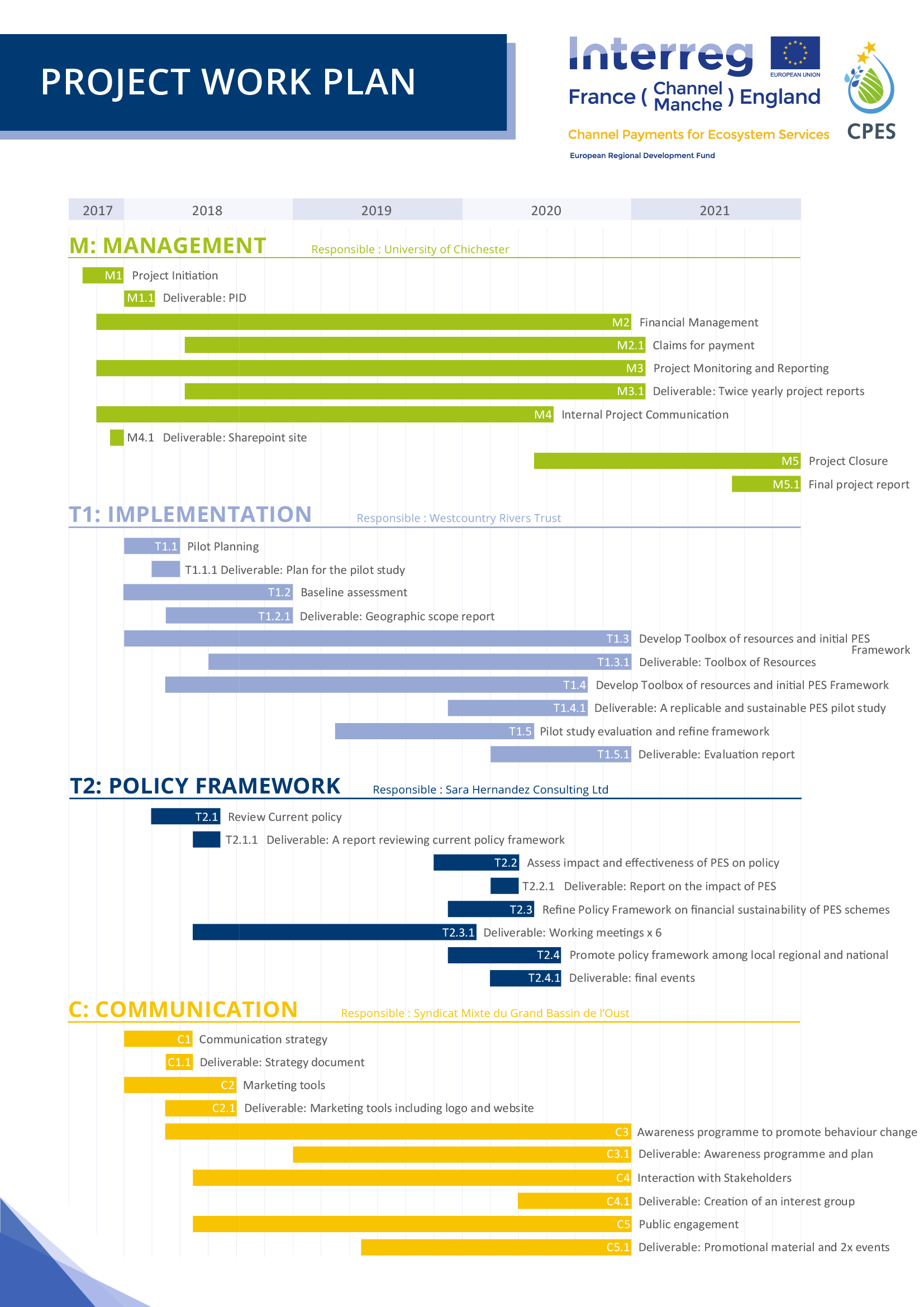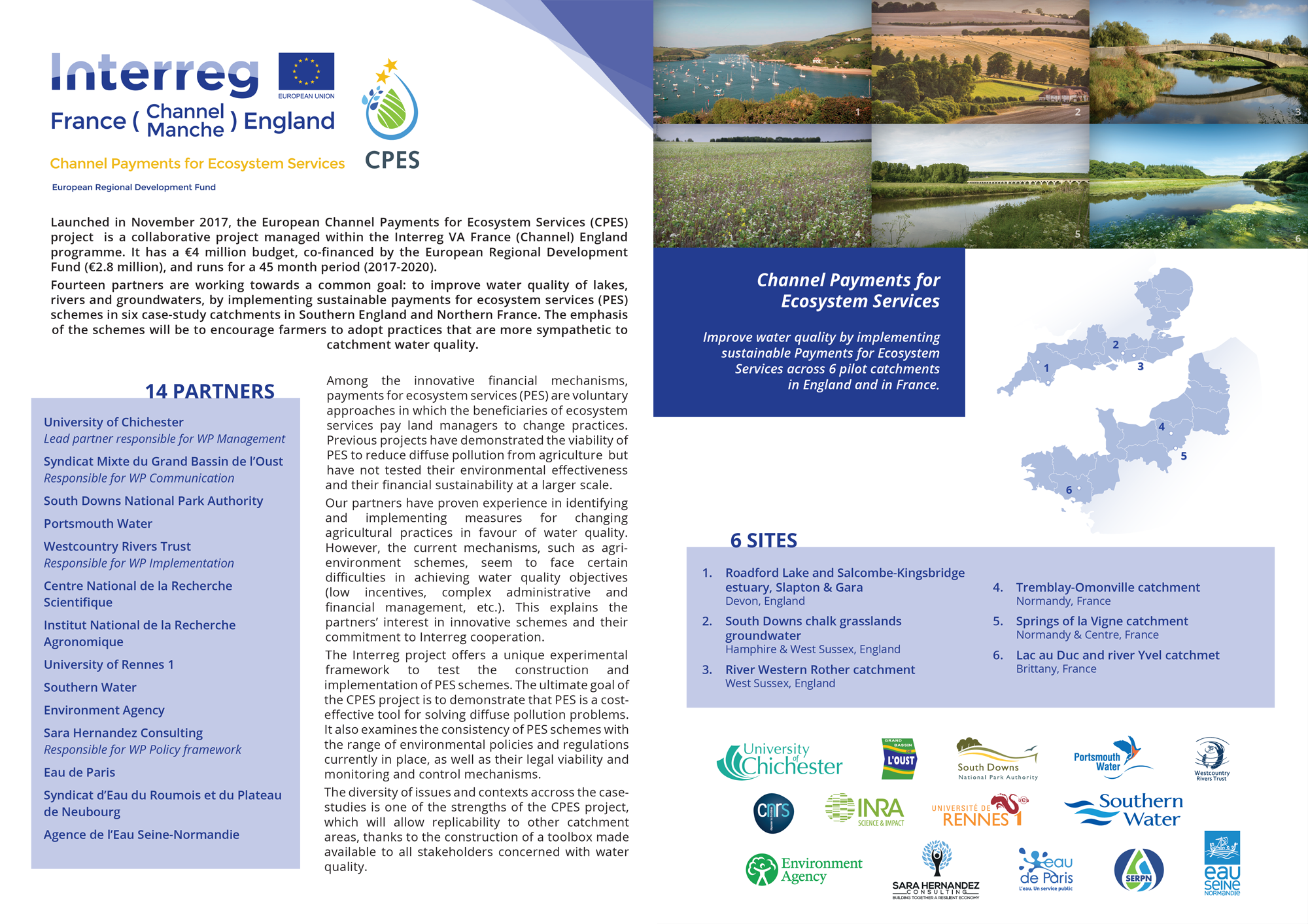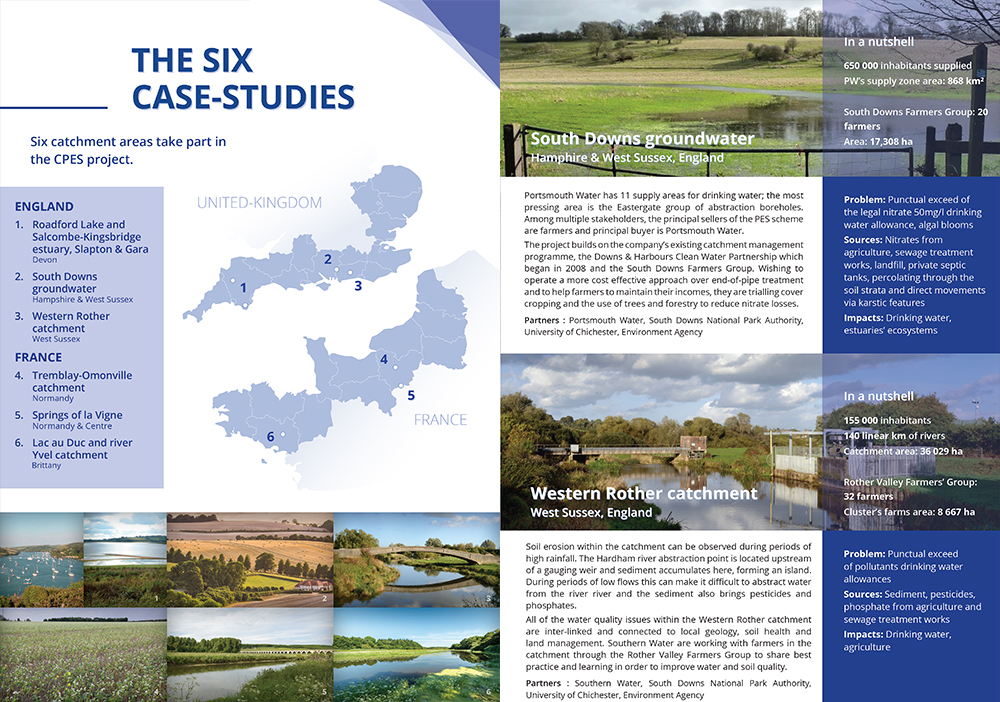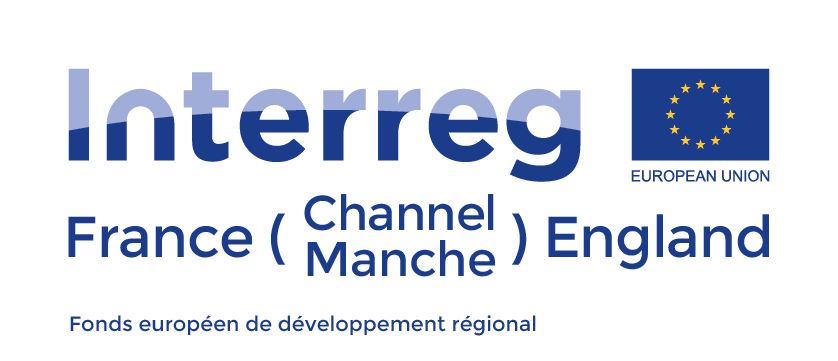
The Project

Channel Payments for Ecosystem Services (CPES) is a cooperation project managed within the Interreg VA France (Channel) England programme. It has a €4 million budget, co-financed by the European Regional Development Fund (€2.8 million), and runes for a 45 month period (2017-2020). Fourteen partners are working towards a common goal: to improve water quality by implementing sustainable ayments for ecosystem services (PES) schemes in six pilot catchments in Southern England and Northern France.
• Title: « Channel Payment for Ecosystem »
• Project acronym: CPES
• Programme Priority: "Enhance the attractiveness of territories within the FCE area"
• Programme Specific Objective: "3.2 Enhance and protect the coastal and transitional water ecosystems"
• Specific objective: Incentivising sympathetic land management practices through the implementation of commercially sustainable catchment wide PES schemes.
• Project number: 120
• Name of the lead partner organisation: University of Chichester
• Project duration : from 06.07.2017 to 30.04.2021 (45 months)
• Location of project activities: Morbihan (France), Seine Maritime (France), Cornwall and the Isles of Scilly (England), Devon (England), Hampshire (England), West Sussex (England), Portsmouth (England)

The Channel Payments for Ecosystem Services project
Launched in November 2017, the European Channel Payments for Ecosystem Services (CPES) project aims to improve water quality in rivers and lakes located in the South of England and North of France through the implementation of Payments for Ecosystem Services schemes in six case-study catchments.
60 to 70% of the waters entering the Channel do not reach a Good Ecological State (GES) due to sedimentation,
low levels of oxygen and an excess of nutrients. 30-50% of the groundwater bodies of France and England
do not meet the chemical quality standards of the Water Framework Directive (WFD) due to nitrates.
The intensification of agricultural practices Southern England and Northwest France since the 1970s has resulted in imputs of nitrogen and phosphorus to soils, that are in excess of plant needs. Runoff, erosion and various transfers have transported these nutrients to surface water, leading to degradation of their quality. Termed 'eutrophcation' the most visible manifestation of this degradation is the phenomenon of eutrophication, marked on the marine coast is marked by the development of green tides, and at the level of the continental water bodies by cyanobacterial blooms. It is accompanied by ecological, economic and cultural-aesthetic losses.
Drinking water managers are increasingly faced with the risk of source water exceeding health and chemical quality standards in many underground and surface water sources. The persistence of this situation can represent a significant economic cost for water managers, depending on the impact on quality: increase of water treatment costs, abandonment of catchments, establishment of new connections, construction of new treatment works, adaptation of treatments to new molecules, closures of tourist sites, reduction of fishing stocks, etc.
In France, estimates made in 2012 showed that the pollution of river catchments by high
nitrate concentrations could cost between 24 and 60 million euros per year.
The lost benefits resulting from the loss of good ecological status of these areas could
represent between 1113 and 2295 million euros per year (French Ministry of Ecology, 2012).
Faced with this situation, public authorities at both European and national levels have put in place regulations and financial mechanisms to encourage farmers to change their practices. Applied in a uniform manner and based on the principle of strict compensation for the additional costs generated by these modifications, the regulations and mechanisms put in place have produced results.
In Brittany, for example, monitoring is beginning to show lower nitrate concentrations in most rivers.
In France, the evaluation of the first cycle of the WFD shows improvements in the state of water bodies
but significant challenges remain regarding diffuse pollution from agriculture.
However, this strategy is running out of steam in the face of a persistent difficulty in achieving the initial objectives assigned (that is, to ensure that coastal and inland waters are in good ecological status). A major obstacle is that the policies applied today do not full internalize the environmental costs within the production costs and neither do the prices paid to farmers by the buyers.
This relative failure leads us to think about the implementation of better financial tools that are better able to achieve the objective of good ecological status inaquatic ecosystems: to prevent sources of pollution and to protect the water resource and the ecosystem services offered. The WFD plays an important role in integrating catchment management into national strategies, as well as Agri-Environmental Measures (AEM) from the Common Agricultural Policy (CAP), which offer subsidies to farmers for changes towards more respectful practices for the environment and water resources. However, these strategies are insufficient to achieve the objectives of the WFD as there is not enough incentive to mobilize farmers and their administrative and financial management is very complex. Adapting farming practices improves the situation, but farmers, in a context of limited profitability, are not sufficiently incentivized to change.
The Interreg project offers a unique experimental framework to test an innovative financial mechanism to address the challenges of water quality and financial sustainability to make the management of catchment areas more effective in the long term. The implementation of PES in different catchment areas allows a generalization of the commercial and sustainable application of the PES concept across varying geographies.

What are Payments for Ecosystem Services?
Among the innovative financial mechanisms, payments for ecosystem services (PES) are voluntary approaches in which land managers are paid to change practices by the beneficiaries of the ecosystem services. Through financial incentives, they encourage the implementation of more efficient farming methods for nutrient management, such as cross contour tillage, targeted fertilizer use and tree planting, which help to significantly reduce the levels of nutrients transferred into the river system. At the same time, they reduce losses to the farmer to levels beyond those in current environmental regulations and policies.
PES incentives are financed through the establishment of a market in which land managers are paid by the beneficiaries of the ecosystem service, i.e. those who benefit from a cleaner water supply such as water companies, tourist establishments, etc.
Example: The increase in agricultural costs associated with the implementation of green practices
will be covered by savings due to reduced water treatment and profit from increased tourism.
The PES has the dual theoretical specificity of being more flexible (better adaptation to local specificities) and leading to a greater internalisation of environmental costs. It could therefore be more efficient than the policies currently implemented in achieving the objective of good ecological status.
Previous projects (WATER, Defra and Vittel) have demonstrated the viability of PES but have not tested their commercial sustainability. The Interreg CPES project aims to demonstrate that PES are more efficient and sustainable in solving the problems of diffuse pollution, by overcoming certain difficulties encountered by the AEMs as well as by these experiments. One of the priorities of a PES scheme is building trust between buyers and sellers by having a clear business framework, return on investment, relationship between risk and reward on the buyers side; and by having impact on contractual arrangements, income security, tax implications and implications for insurance on the sellers side.
The project also examines how to better integrate these mechanisms into the continuum of environmental policies and regulations currently in force at European and national level. It also compares the implementation of these mechanisms in two countries subject to different constraints in the organization of agricultural sectors and in different traditions and modes of organization in terms of the respective roles of the public and private sectors in management and environmental regulation. Finally, the CPES project aims to evaluate how the scenarios and tools implemented and tested locally can be extended to all watersheds located on both sides of the Channel.

One common action for different contexts
Based on the case study characteristics, the partners are working to create common tools, which aim to bring out replicable PES mechanisms at many sites. The diversity of issues and contexts is one of the main strengths of the CPES project. The actions of the project fall into 4 defined work packages with their deliverables: M - Project Management; T1 - Implementation; T2 - Policies; C - Communication
A common methodological framework has been put in place to allow comparison between case studies and adaptation to the particularities of each territory; the active phases are as follows:
The diagnosis
This phase makes it possible to determine the economic justifications of the PES. Each case study brings together all baseline information on water quality status, as well as information from previous work: watershed characteristics, water quality, function and value. ecosystem services, environmental impact and pressures in the perimeter and socio-economic potential of local actors (businesses, landowners, farmers, water companies, local authorities, tourism organizations). This information is then used in studies concerning the cost-benefit analysis of a comparative situation with and without PES measures, the economic evaluation of services provided by agricultural practices and the analysis of the effectiveness of current state aid for farmers.
The development of the PES mechanism
In this phase, the auction system is used to reveal the value of the most acceptable payment to farmers. Its protocol and implementation modalities contribute to the design of the PES, complemented by participatory workshops on PES governance. At the end of this phase, the assessment of the financing needs and the financial arrangement specific to the case study are determined.
One of the major deliverables of the project is a reproducible method which can account for the geographical diversity of the watersheds as well as the cultural, political and legal diversity of the two countries. Every six months, partners come together to share their experiences and individual advancements and develop a toolbox of ecosystem service models, financial instruments, trade agreements, models of engagement for clusters of companies and communication tools, adapted to catchment areas with different environmental, legal, cultural and political frameworks of France and England.
The implementation phase of the PES
Implementation covers the whole process of consultation and negotiation with farmers and local actors. The implementation of the PES allows, at the end of the project, the evaluation of the effectiveness of the mechanism on the quality of the water resource, the social equity and the collective governance of the watershed. Monitoring is carried out by the sites during and after the project to ensure the continuity of the improvement of the mechanism: improvement of water quality, reduction in eutrophication, decrease insedimentation, and financial benefits.
CPES will actively contact stakeholders (OFWAT, DG MARE, DG ENVIRO, DG AGRI, French Regional Councils and National Farmers' Unions, among others) to produce a policy for framing and implementing PES as intervention models and sustainable policy to integrate into future projects. The main results will influence policy development at EU level.
Dissemination of results
The results of the case studies are disseminated to promote the benefits of the PES system and to encourage other actors to engage with the mechanism. From the earliest stages of the project, communication between buyers and sellers is essential: to raise awareness, to develop interest, to fully involve these actors in activities and to encourage the sustainable application of systems in the long term.
The dissemination strategy of the project targets the actors involved in the PES system: farmers, policy makers, international organizations, sectoral agencies, public service providers, business support organizations, higher education and research institutions, associations, etc.
Events (conferences, seminars, workshops, meetings ...) and publications (brochures, press releases, conference articles, articles in professional journals) are amplified through a website and social media.

Six pilot sites
Six catchment territories take part in the CPES project. Find their details, descriptions and news in the dedicated pages:
- Salcombe-Kingsbrigde Estuary, Gara and Slapton & Roadford Lake catchments, Cornwall & Devon, England
- South Downs chalk grassland groundwater, Hamphire & West Sussex, England
- River Rother catchment, West Sussex, England
- Tremblay-Omonville Catchment, Normandy, France
- Springs of La Vigne, Nomandy & Center, France
- Lac au Duc and Yvel-Hyvet river catchment, Britanny, France
Click on the picture below to read short descriptions of the case studies

The partners
Eleven partners are directly related to the CPES project and 3 are associated with the case studies. The partnership includes organizations with complementary levels of cross-channel expertise and experience on the different aspects of the ecosystem life cycle and PES deployments. These include: water companies, representatives of farming communities, watershed managers, water quality analysists, researchers, change managers, economic modellers, communication experts and policy developers.
- University of Chichester (UK) - Leader partner and coordinator of WP Management
- Syndicat Mixte du Grand Bassin de l’Oust (France) - Coordinator of WP Communication
- South Downs National Park Authority (UK)
- Portsmouth Water (UK)
- Westcountry Rivers Trust (UK) - Coordinator of WP Implementation
- Centre National de la Recherche Scientifique (France)
- Institut National de la Recherche Agronomique (France)
- University of Rennes I (France)
- Southern Water Services (UK)
- Environment Agency (UK)
- Sara Hernandez Consulting (France) - Coordinator of WP Policies
- Syndicat d’Eau du Roumois et du Plateau de Neubourg (France)
- Eau de Paris (France)
- Agence de l’Eau Seine-Normandie (France)
To get to know them better, you can visit the page Partners wich shows all the detailed descriptions. In addition, partners act on the scale of each case study: find them on the dedicated pages of the Pilot Sites.
The Interreg France (Channel) England Programme is a European Cross-Border cooperation programme which aims at funding high quality cooperation projects in the Channel border region between France and England, in line with the Europe 2020 strategy. These projects aim to find common solutions to common problems which exist in multiple countries.
The Interreg France (Channel) England Programme is funded through the European Regional Development Fund (ERDF).







